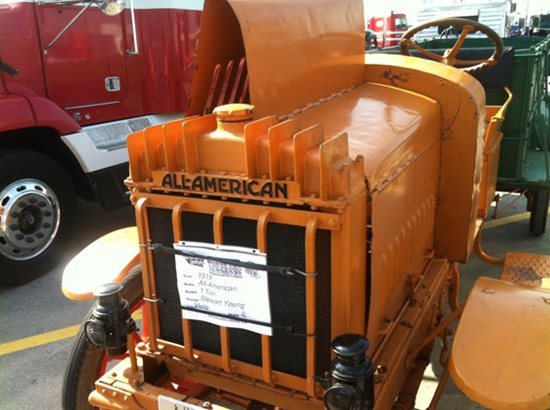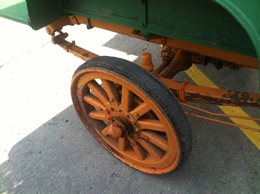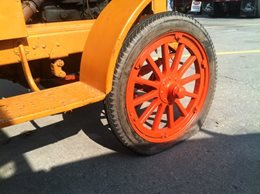 |
| This 1919 All American was just one of the many interesting historical trucks on display at the Walcott Truckers Jamboree . |
In July, my fellow Freightliner Team Run Smart Pro Jeff Clark and I attended the Walcott Trucker’s Jamboree in Walcott, Iowa. This show is interesting as it includes some of the most modern equipment, as well as historical and antique trucks.
During the show, Jeff and I enjoyed meeting many new people as we discussed all the variations of old and new and how today modern technology has evolved. Basically, we met three different types of people in their opinions. Some were thrilled with the latest trucks which feature every new gadget and technology. Some were luke-warm to the newest innovations, and they like to pick and choose what they like. Finally, the third group preferred the older models and refused to accept anything new or updated. In my opinion, just because something is new, it doesn’t mean that it’s always better. This would put me into the pick and choose category. However, I usually end up liking the new after it becomes familiar to me. Change is often difficult when we’ve been doing something the same way for a long time.
Jeff and I happened to be walking into the show one morning when all of a sudden we spotted a 1919  All American One Ton Truck. We stopped to take a closer look as in many ways this unit had many similarities with its predecessor “the horse drawn wagon.” At the same time, this truck offered a hypoid ring and pinion rear axle, water cooled engine, pressurized cooling system and rudimentary lighting system. I’m not sure if it had an electric starter as it had a hand crank on the front which may or may not have been a backup system. This truck had an interesting combination of technologies due to the fact that it had solid rubber rear tires and pneumatic tires on the steer axle. This made me begin to think about tires and how people would have accepted this modern idea of having air to support the weight of a vehicle through the use of a pneumatic tire.
All American One Ton Truck. We stopped to take a closer look as in many ways this unit had many similarities with its predecessor “the horse drawn wagon.” At the same time, this truck offered a hypoid ring and pinion rear axle, water cooled engine, pressurized cooling system and rudimentary lighting system. I’m not sure if it had an electric starter as it had a hand crank on the front which may or may not have been a backup system. This truck had an interesting combination of technologies due to the fact that it had solid rubber rear tires and pneumatic tires on the steer axle. This made me begin to think about tires and how people would have accepted this modern idea of having air to support the weight of a vehicle through the use of a pneumatic tire.
I decided to look into the evolution of what we call a tire. The earliest tires were bands of leather, then iron and later steel and were placed on wooden wheels to be used on carts and wagons. Later on, there were solid rubber tires and in 1888 the first pneumatic tire was created by John Boyd Dunlop. John was a proprietor of one of Ireland’s most prosperous veterinary practices. His son had been prescribed cycling as an exercise from his doctor Sir John Fagan. Dunlop and Fagan began working on the idea of a pneumatic tire in an effort to prevent headaches his ten year old son was experiencing while riding on rough pavement. These early tires were mainly used on cycles and lightweight vehicles. Rubber became stronger and more durable due to the development of vulcanization of natural rubber credited to Charles Goodyear and Robert William Tomson. Synthetic rubbers were invented by Bayer in the 1920’s. All the tires at this point were bias-ply in construction and a tube type tire which is where the inner- tube inside the tire encapsulates the air. It looks like the idea of tubeless tires started as early as 1928 and due to technical problems most of the early designs only saw limited production or were abandoned. It wasn’t until 1955 that tubeless tires became standard equipment on new cars. In 1946, Michelin had developed the radial tire which offered superior handling and fuel economy. This technology quickly spread throughout Europe and Asia however the US relied on the outdated bias-ply tire construction well into the early 1970’s. In fact, the market share of bias-ply tires was 87% in 1967. I can still remember the resistance by many to the adoption of radial tires .
During my research, one final interesting point that I came across was how often pneumatic tires went flat. This was due to horseshoe nails which littered the dirt roads of the era. The point of this story is to think about where our opinions and prejudice would have fallen on this modern marvel which we readily accept today as the pneumatic tire.
 |
 |
| The durable and dependable solid rubber tire . |
The advanced /futuristic pnuematic tire displaying its lack of dependability. |